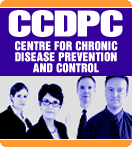![]()



|
|
|||||||||||||||||


 |
|
||||||||||||||||

|
Centre for Chronic Disease Prevention and Control
There are many different types of cancers. All of them are characterized by uncontrolled growth and spread of abnormal cells in the body. According to the Canadian Cancer Statistics 2002, an estimated 136,900 new cases of cancer and 66,200 deaths from cancer will occur in Canada in 2002. With the exception of non-melanoma skin cancer, the most frequently diagnosed cancer will continue to be breast cancer for women and prostate cancer for men. The leading cause of cancer death for both sexes continues to be lung cancer. There are many known risk factors for cancer. Some risk factors are not modifiable (age, gender, genetic predisposition). Modifiable risk factors include:
Additional risk factors for cancer include exposure to workplace or environmental carcinogens, certain infections, and reproductive patterns. |
|
||||||||